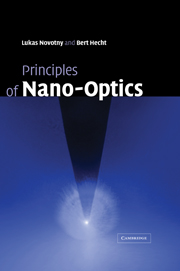Book contents
- Frontmatter
- Contents
- Preface
- 1 Introduction
- 2 Theoretical foundations
- 3 Propagation and focusing of optical fields
- 4 Spatial resolution and position accuracy
- 5 Nanoscale optical microscopy
- 6 Near-field optical probes
- 7 Probe–sample distance control
- 8 Light emission and optical interactions in nanoscale environments
- 9 Quantum emitters
- 10 Dipole emission near planar interfaces
- 11 Photonic crystals and resonators
- 12 Surface plasmons
- 13 Forces in confined fields
- 14 Fluctuation-induced interactions
- 15 Theoretical methods in nano-optics
- Appendix A Semianalytical derivation of the atomic polarizability
- Appendix B Spontaneous emission in the weak coupling regime
- Appendix C Fields of a dipole near a layered substrate
- Appendix D Far-field Green's functions
- Index
10 - Dipole emission near planar interfaces
Published online by Cambridge University Press: 05 June 2012
- Frontmatter
- Contents
- Preface
- 1 Introduction
- 2 Theoretical foundations
- 3 Propagation and focusing of optical fields
- 4 Spatial resolution and position accuracy
- 5 Nanoscale optical microscopy
- 6 Near-field optical probes
- 7 Probe–sample distance control
- 8 Light emission and optical interactions in nanoscale environments
- 9 Quantum emitters
- 10 Dipole emission near planar interfaces
- 11 Photonic crystals and resonators
- 12 Surface plasmons
- 13 Forces in confined fields
- 14 Fluctuation-induced interactions
- 15 Theoretical methods in nano-optics
- Appendix A Semianalytical derivation of the atomic polarizability
- Appendix B Spontaneous emission in the weak coupling regime
- Appendix C Fields of a dipole near a layered substrate
- Appendix D Far-field Green's functions
- Index
Summary
The problem of dipole radiation in or near planar layered media is of significance to many fields of study. It is encountered in antenna theory, single molecule spectroscopy, cavity quantum electrodynamics, integrated optics, circuit design (microstrips), and surface contamination control. The relevant theory was also applied to explain the strongly enhanced Raman effect of adsorbed molecules on noble metal surfaces, and in surface science and electrochemistry for the study of optical properties of molecular systems adsorbed on solid surfaces. Detailed literature on the latter topic is given in Ref.[1]. In the context of near-field optics, dipoles close to a planar interface have been considered by various authors to simulate tiny light sources and small scattering particles. The acoustic analog is also applied to a number of problems such as seismic investigations or ultrasonic detection of defects in materials.
In his original paper, in 1909, Sommerfeld developed a theory for a radiating dipole oriented vertically above a planar and lossy ground. He found two different asymptotic solutions: space waves (spherical waves) and surface waves. The latter had already been investigated by Zenneck. Sommerfeld concluded that surface waves account for long-distance radio wave transmission because of their slower radial decay along the Earth's surface compared with space waves. Later, when space waves were found to reflect at the ionosphere, the contrary was confirmed. Nevertheless, Sommerfeld's theory formed the basis for all subsequent investigations. In 1911 Hörschelmann, a student of Sommerfeld, analyzed the horizontal dipole in his doctoral dissertation and likewise used expansions in cylindrical coordinates.
- Type
- Chapter
- Information
- Principles of Nano-Optics , pp. 335 - 362Publisher: Cambridge University PressPrint publication year: 2006
- 2
- Cited by



